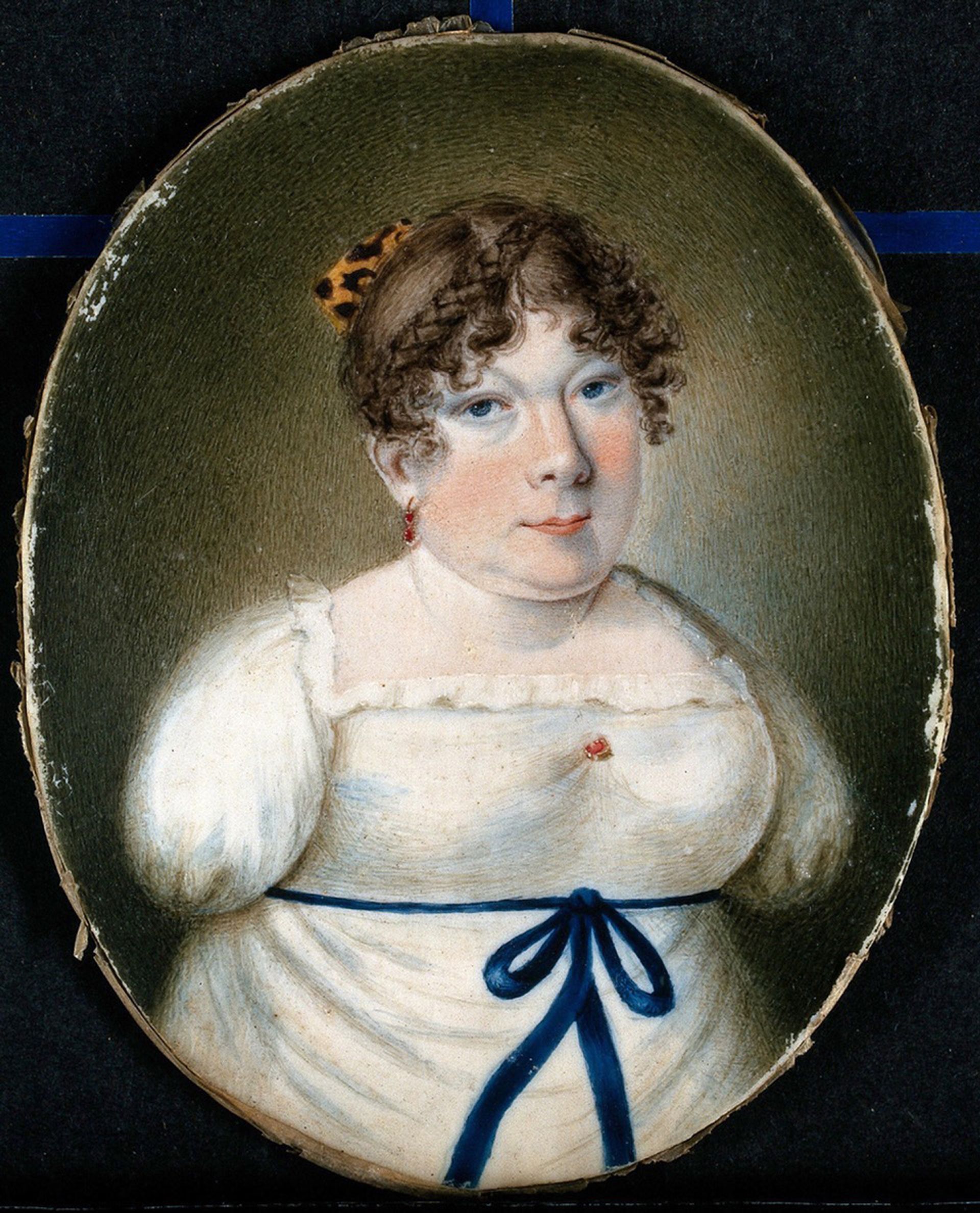
A unique figure from the annals of art history has found sudden success on the auction block, with a small watercolor by Victorian miniature painter Sarah Biffin nearly doubling its high estimate of £5,000 ($6,680) to sell for £9,000 ($12,023) at Sworders Fine Art Auctioneers in the U.K.
The artist, who was born without arms or legs, was a member of a traveling a circus in England, where she was billed as “The Limbless Wonder.”
Born into poverty in Somerset in 1784, Biffin likely suffered from a condition called phocomelia. She nevertheless taught herself to write, paint, sew, and use scissors with her teeth. She joined the circus at age 13, where she earned £5 a year to paint for crowds at fairs, and sold her miniatures for three guineas each.
The 1812 watercolor work, Study of Feathers, that sold at auction last week, also came with a handbill advertising a 28-year-old Biffin as a circus attraction, according to Smithsonian Magazine.
“Born deficient of arms and legs, she is of comely appearance… [and] displays a great genius,” the ad proclaimed. “[Biffin] writes well, draws landscapes, paints miniatures, and many more astonishing things, all of which she performs principally with HER MOUTH.”
A traveling circus handbill advertising Sarah Biffin. Photo courtesy of Sworders.
“As a disabled woman artist working in the early nineteenth century, [Biffin’s] remarkable story is one of perseverance and resilience,” University of Notre Dame scholar of literature and disability studies Essaka Joshua, wrote for nonprofit Art UK. “By the time of her death, she was a celebrated miniaturist.”
Biffin’s fame was so great that Charles Dickens mentioned her in several novels. But more significantly to her artistic career, in 1808 she attracted the patronage of the George Douglas, the 16th Earl of Morton, who arranged for her to have lessons with lessons from a Royal Academy of Arts painter William Marshall Craig.
In 1821, London’s Royal Society of Arts awarded Biffin a silver medal for one of her historical miniatures in 1821, and the Royal Academy exhibited one of her paintings in 1850, just months before her death at age 66.
Biffin’s portrait miniatures became popular, and she set up a studio on Bond Street in London. Members of the royal family were among those who commissioned her work. Queen Victoria bought Biffin’s 1839 portrait of her father, Edward the Duke of Kent, and it is in the Royal Collection Trust to this day.
Sarah Biffin, Edward, Duke of Kent (1839). Queen Victoria purchased this watercolor miniature of her father from Biffin. Collection of the Royal Trust Collection.
This isn’t the first time Biffin’s work has smashed auction expectations. Until December 2019, her auction record had stood at just £2,040 ($3,383) for a decade, according to the Artnet Price Database.
Then Sotheby’s London included an 1821 self portrait by Biffin in its “The Pohl-Ströher Collection of Portrait Miniatures, Part III” auction. The work, which had previously sold at Sotheby’s back in 1986, is probably her most famous, having been reproduced in engravings during her lifetime.
Sarah Biffin, Sarah Biffin Self Portrait Before Her Easel (ca. 1821). The watercolor on ivory sold for £137,500 ($180,125) on a high estimate of £1,800 ($2,360). Photo courtesy of Sotheby’s London.
“[Biffin] represents such strength in overcoming not only the prejudice that would undoubtedly have been shown towards a professional female artist but also towards someone who would have been viewed as a circus freak,” Emma Rutherford, a portrait miniature specialist at London’s Philip Mould and Company, wrote of the work.
“The odds were stacked against her at birth, but here we are presented with the image she made of herself, the image she wanted to present to the world,” she added. “Here, [Biffin] is viewed first and foremost as an artist, surrounded by the tools of her trade, including the brush tucked into her sleeve ready for her paint.”
Sarah Biffin, Study of Feathers (1812) and a handbill advertising her appearance at a circus. Photo courtesy of Sworders Fine Art Auctioneers.
Though the estimate topped out at just £1,800 ($2,360), a furious bidding war saw the work sell for £137,500 ($180,125). It was Biffin’s top result ever at auction—and more than 9,000 percent in excess of the middle estimate.
“The story of Biffin’s life and the fact that she was so talented considering her disability is what really attracted the bidders,” Philip Mould director Lawrence Hendra told Antiques Trade Gazette following the sale, in which he had been an underbidder. “People have a profound respect for those who are able to overcome adversity, and I can think of few other artists who achieved this to a greater extent than Biffin.”
Sarah Biffin, Study of Feathers (1812). The watercolor sold for £65,520 ($90,335), on a high estimate of £6,000 ($8,272). Photo courtesy of Sotheby’s London.
The artist’s resurgence has continued over the past two years.
In July, at Sotheby’s London, another version of Study of Feathers sold for £65,520 ($90,335), despite an estimate topping out at £6,000 ($8,272).
The Study of Feathers that hit the block this month was from collection of the late Cambridgeshire antiques dealer Peter Crofts—a double amputee who lost his legs in a piloting accident in 1945.
“Crofts obviously had this sympathy, this connection with Biffin, which was quite interesting,” Sworders’ chairman Guy Schooling told the Art Newspaper. “Her work is quite extraordinary by any standard. She’s caught the zeitgeist, there’s a great resurgence in interesting female artists. And her prices are rocketing.”